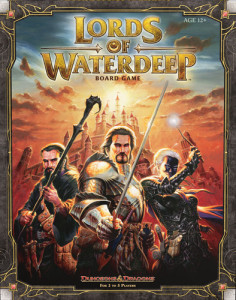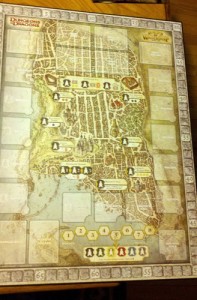
The city of Waterdeep.
This is probably a name you recognize if you have even a passing familiarity with the lore of the Forgotten Realms or Dungeons and Dragons in general. At times within the world’s history, this trade hub is one of the largest and most influential cities within the Realms. And the people in charge of governing and leading the city is a group known as the Lords of Waterdeep – a group of men and women who kept their identities hidden in order to guide the city.

And now, you too can join the ranks of the Lords of Waterdeep. Released by Wizards of the Coast in 2012, the Lords of Waterdeep board game was designed by Rodney Thompson and Peter Lee. It is primarily a game of worker placement that puts you in the role of one of the secretive Lords of Waterdeep, using your various agents to further your own agenda and become the greatest of the Lords in the city. The base set handles 2-5 players and plays in about an hour.
Each player chooses which faction will be representing his Lord. In the base set there are five factions to choose from. There are the Knights of the Shield, the City Guard, the Silverstars, the Harpers, and the Red Sashes. Which faction you choose has no impact on the gameplay beyond which color of piece you will control, so simply choose your favorite. You will take a number of Agents based on the number of players in the game. This is how you will move about the city in order to gather your resources to earn victory points. You will also receive a Lord card, which you will keep secret from the other players. Each Lord wants to complete different kinds of quests in order to score additional victory points at the end of the game. Finally, each player will receive several Quest cards and Intrigue cards.
Quest cards come in one of five main varieties – Arcana, Piety, Skulduggery, Warfare, and Commerce and require you to expend resources to complete them. Completing Quests is the main way you will gain Victory Points during play. Intrigue cards have a variety of different effects that can hinder an opponent or give you some kind of boost. More of each of these cards can be obtained through play

The game itself is on a timer, lasting a total of 8 rounds before final Victory Point tallies are counted and a winner is declared. Players take turns placing their Agents in various buildings around the city. Most of these buildings allow the player to gather resources like adventurers or gold that are required to finish quests and can also hold a single Agent. Once an Agent has been placed into a building, that building cannot be used again that round. But there are a few special buildings that break these rules.
The first is the Cliffwatch Inn, which allows the player to draw a new Quest from a group of four available Quests. This building can support up to three Agents. They can take one of the faceup Quest cards and some gold or a Quest card and an Intrigue card. Additionally, they can also reset the available Quests and then take one of the newly drawn. This can be an effective way of denying opponents access to Quests with high Victory Point rewards or if you know they are seeking out certain kinds of Quests.
The second special location is Castle Waterdeep. This building only supports a single Agent, but placing one there gives the controlling player the “first player marker” allowing you to go first on the next round of play and also lets them draw an Intrigue card.
The third special location is Waterdeep Harbor which allows a player to play an Intrigue card. The card resolves immediately. Finally, any Agents that are played here get to be reassigned to another location once all other Agents are placed, allowing them an additional placement. This building can support up to three Agents, and they are reassigned in the order they were played.
The final special building is the Builder’s Hall. There are a number of special building cards that can be purchased from the Builder’s Hall. There are three buildings available for purchase at any given time, drawn randomly from the stack. A building that is purchased gets put on the game board under that players control, and is available to have an Agent assigned to it. These advanced buildings generally give players access to bigger quantities or more powerful resources than the basic buildings. However, the owner of the building gets a small benefit if another player places one of their Agents there.
That’s really all there is to the game. Each player takes their turn placing one of their Agents to a free building and then completing a Quest if they are able to. They continue placing Agents, gathering resources, and completing Quests until there are no more Agents left to be placed. Then the next round of play begins. For the final four rounds of play, each player gets one additional Agent to place, giving them more options to gather resources and complete higher value Quests. When the game ends, you score your final Victory Points for unspent resources as laid out in the game book and any bonuses for completed Quests based on your specific Lord. The player with the highest Victory Point total is declared the winner.
It’s a really straightforward game, but there are enough wrinkles to keep it interesting. After several play throughs, most of the fun comes from trying to guess which of the Lords the other players have and maneuvering to stop them from completing the kinds of Quests that will give them big bonuses at the end of the game while not getting caught in the same trap yourself.
The game itself looks really good. The board is solid and looks like a stylized map of the city that one might find in a Gazeteer section of a Dungeons and Dragons book. A Victory Point tracker runs around the edge of the board allowing players to see where they stand at any given point in the game. The adventurer cubes are solid and pleasing to look at, as are the gold pieces. Finally, the box design is really pleasing. Everything has a clear place in the box and everything fits snugly inside, making even the task of packing and unpacking the game pleasant.
If you are a fan of Dungeons and Dragons or Euro-style board games, I cannot recommend this one enough. As I have stated before, I am not a big board gamer, but this is one of my favorite games that my wife and I own and will play time and again without complaint. There is also an expansion to the game, Scoundrels of Skullport, which adds a new faction to the game along with other new features. I haven’t had a chance yet to pick this up, but it is definitely on my list.
